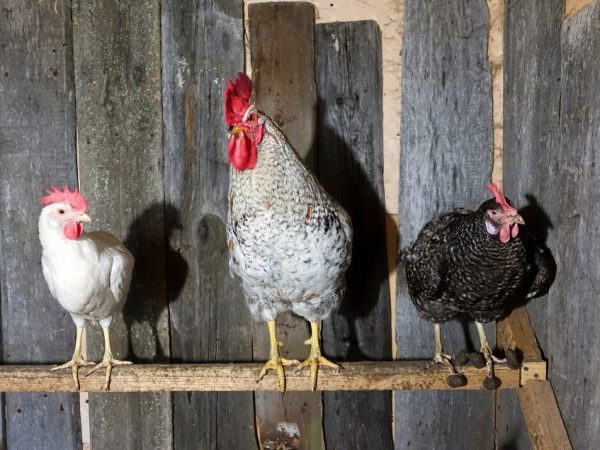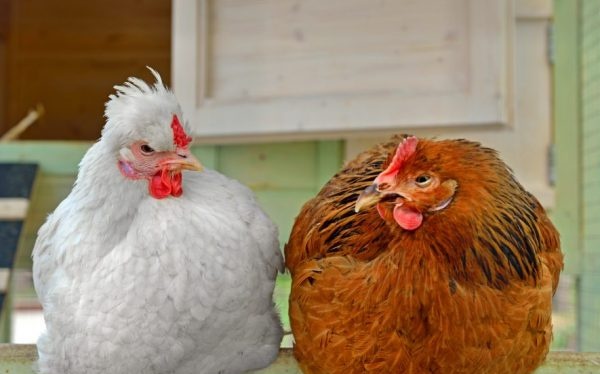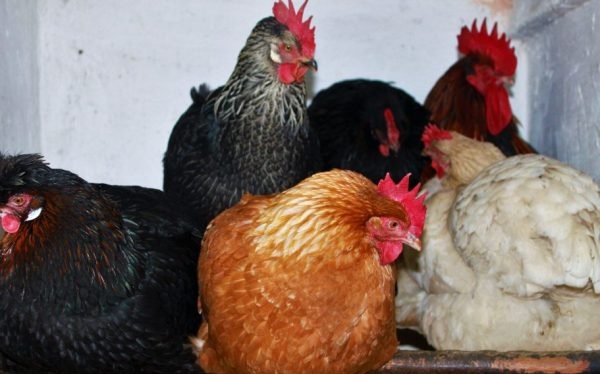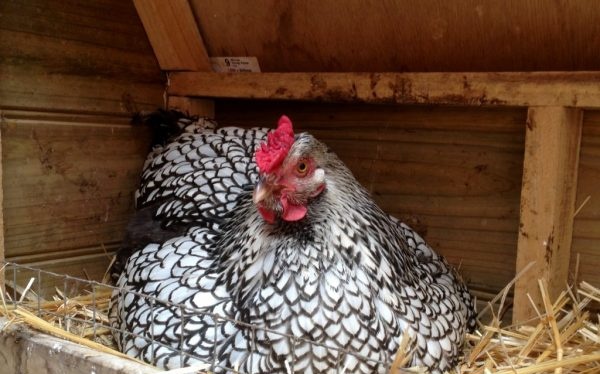Do-it-yourself chicken roost - simple instructions
When breeding poultry, each breeder tries to create the most favorable conditions in order to ensure high production rates. Of no small importance in comfort is a roost for chickens, which many make with their own hands from scrap materials.

Do-it-yourself chicken roost
Role of the chicken perch
In the conditions of its natural environment, the bird prefers to sit not on the ground, but on branches, a fence and other elevation.
When kept in a chicken coop, a special roost is organized, which is located at some distance from the floor.
Domestic chickens in a sitting place not only rest during the day, but also sleep at night.
Another task of this design is to prevent contact with the surface, where a large number of pathogens of fungal and viral diseases are collected. Thus, the perch plays a preventive role, protecting the hens from disease.
Basic design requirements
The main requirement is a sufficient height and spaciousness of the structure so that the chickens do not experience a crush. Therefore, the physiology of the livestock and its number are taken into account.
Another rule for arranging poles is strength and stability. They must be able to support the weight while sitting and moving.
The bar where the chickens will sit and rest should be comfortable to grip, allow them to be held even in the sleep stage.
Furniture shelves, flat wooden boards and thick logs are not suitable for manufacturing - they will be uncomfortable on them.
Suitable materials:
- a bar of wood without knots and splinters of the width of the free girth, namely 1/2 the length of the open chicken paw, depends on the breed;
- the type of bars is rounded, without right angles;
- the surface is smooth, sanded with sandpaper, not capable of causing mechanical injury.
The optimal size of a wooden blank is with a section of 4 * 6 cm or 5 * 5 cm.
When calculating the length and number of poles, take into account:
- from 0.2 to 0.35 m for each layer of meat and meat direction, respectively, with an interval between strips from 0.3 m;
- from 0.15 m for each chick with an interval of 0.2 m.
Given these dimensions, one 2.4 m pole can hold about 17-18 birds.
If the space in the hen house allows, it is better to make the roost with a margin, in order to avoid throwing off the weak chickens by the stronger ones. They are often made removable to make it easier to change.
Place and rules of placement

The roost should be located in the warmest place
The most suitable place for a roost is the warmest remote area near the far wall, away from extraneous noise, window openings and doors.
Finished structures are placed at the same distance, single-tier ones - at the same level. The distance that must be retreated is from 0.25 m so that the bird does not touch the wall surface with its tail.
It is not necessary to equip poles near the entrance to the premises, because drafts are possible here.
Some poultry houses combine two ideas in one to save space: equip a sitting place and a nest for laying eggs.
For this purpose, they place the roost where the nest with an egg collector for chicken eggs is equipped, fixing the beams at a height of about 0.3 m.
An important condition: regular frequent cleaning, because both the nest itself and the shell will be contaminated with droppings.
Varieties of chicken perches
Chicken roosts are of several types. Each of them has its own advantages and disadvantages. They choose the appropriate option, taking into account the dimensions of the chicken coop, the layout of the internal space, the size of the livestock and the breeds being raised.
Multi-tiered
Provides for seating at several levels in the form of a ladder. The gap between the tiers is from 0.5 m. This distance is enough for the chickens to move freely along the poles.
Such original models are usually made from wooden beams and are often placed as cells or separate planks assembled together in a corner in a triangular shape, or they are placed parallel to the wall panel.
They take up little space and save space in a small chicken coop.
It is better to build reclining structures - this will simplify cleaning and maintenance.
Multi-tiered perches have a couple of disadvantages:
- lack of hygiene - droppings from birds located on top often fall to the lower level, staining those that sit below;
- bird quarrels - in attempts to climb as high as possible, chickens often come into conflict.
Single-tiered
A single-tier roost is a simple device that is mounted at a distance of 0.35 to 0.5 m from the wall panel and at a level of 0.6 to 1.0 m from the floor or ground surface.
The sizes of the intervals depend on the breed of chickens. The drawings are adjusted to the parameters of the bird as much as possible.
The main task when arranging a single-tier sitting place is to firmly fix the bar from a bar so that it does not rotate.
The advantage of the conventional design is that it is hygienic. there are no other poles under the main beam, and all droppings accumulate on the litter placed under the perch. However, it is only suitable for small livestock.
It is not necessary to lay one plank from wall to wall, because under the weight of birds, it will bend and break as a result. The optimal length is up to 3 m. For the stability of the structure, props are installed.
Many poultry houses prefer to use special trays and trays instead of bedding, which further simplifies maintenance and cleaning.
Portable

The portable pole is easier to care for
A portable handrail is a mobile device that is not fixed on a permanent basis, but is installed with the expectation that it can be moved at any time.
Unlike a stationary one, a removable seat is easier to maintain and disinfect by taking it out of the room.
Among the disadvantages:
- small capacity;
- more complex assembly takes a lot of time to manufacture parts.
A portable seating position is a good alternative to placing poultry in temporary housing, for example, in a non-insulated chicken coop during the summer season.
Angular
The roost is performed both single-tier and multi-tiered. This method of placement is suitable for keeping a small livestock, up to 20 individuals.
In the corner structure, the bars are placed between adjacent wall panels. The advantage is the ease of manufacture.
Also, for this purpose, any distant corner in a secluded place will fit, where the birds would be calm.
Among the disadvantages is the inaccessibility to cleaning of multi-tiered options, therefore, it is preferable to make the slats in them removable.
Technology
To make a roost for chickens with your own hands, you must follow the instructions:
- calculate the size of the chicken coop;
- determine the space, taking into account the location of entrance doors, window openings, doors for walking, internal arrangement - nests, drinkers, feeders, bathing boxes with ash and sand;
- choose the appropriate option;
- mark everything on the drawing to check if the selected place will be on the way to feed, drinking water, if it will not be located on the trajectory of air flows, the optimal distance between all zones is 0.5 m.
Tools and materials
As a basis, wood blocks of length are needed, calculated by the breed and the number of livestock.
Tools:
- carpentry hammer;
- sandpaper;
- plane, if any;
- hacksaw;
- screwdriver;
- nails for fastening to the wooden walls of the chicken coop, self-tapping screws with dowels and other fastening material for mounting to masonry.
When building, it is better to take wood of deciduous varieties with a high density that can withstand the weight of birds, for example, birch.
When using coniferous wood bars, the workpieces are pre-fired with a blowtorch to stop the resin from escaping from the tree.
Assembly and installation procedure

The roost is a mandatory attribute of the chicken coop.
The assembly is carried out in several stages, based on the type of structure.
Classic
For the manufacture of the classic version, you will need a bar with a cross section of 6 * 4 cm.
The assembly technology is carried out from parts according to the drawing:
- at the measured required length, the side ends are rounded off, the surface is sanded with sandpaper;
- grooves are formed at the support bars to which the strips will be attached;
- the supports are mounted to the wall panel, the poles are installed in the grooves.
Portable
The portable design is assembled a little differently:
- take a table as a basis, polish its surface;
- in the side edges, one plank is nailed parallel to each other, gutters are formed;
- poles are inserted into the gutters, and the tabletop will act as a pallet.
A portable perch is also made from plywood sheets and wooden boards:
- pre-hammer the box;
- plywood sheet is installed as the bottom;
- pull the mesh on top;
- the strips are fixed in a manner similar to that of a finished table.
Pallet
A pallet in the form of a rectangle is made of a durable and non-corrosive material (for example, a sheet of galvanized roofing sheet). The width and length of the tray should be 0.2 m greater than the perch.
The optimal size that allows the structure to maintain rigidity and not bend is no more than 0.5 m.
The pallet is equipped with sides to a height of 5-8 cm. This will prevent the scattering of debris and give additional stability.
Length: in a single-tier, usually up to 0.6-0.7 m, in a multi-tiered one - up to 1.2 m.
They simplify the process of cleaning the used litter by equipping one of the sides (usually the front one) at an angle of up to 5-10 ° С.
The rest of the sides are fixed strictly vertically in order to connect them to each other horizontally.
The pallet is mounted at the required height (0.3-0.4 m from the floor) on wooden, metal, plastic slats, or installed on a pre-made flooring under the perch.
The tray is lined with sawdust or filled with coarse river sand. When moisture appears, dry lime is added to the filler.
For convenience and ease of cleaning, it is recommended to make the pallet removable.
Ladder
A ladder is often placed to the perch at an angle of 60 ° C with a distance between the beams of no more than 0.2 m.
However, some poultry houses are sure that this is an unnecessary detail for laying hens, who must be in proper physical shape and fly freely to a small height.
Summing up
Chickens are resting on the roost, so this device is irreplaceable.
The design is of several types. All options are easy to make with your own hands.
The chickens must be taught to the new place by hand planting on poles in the evenings. It will take from 1 week.


